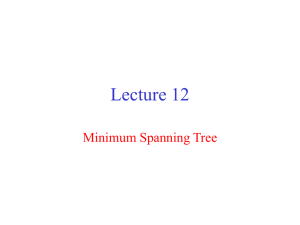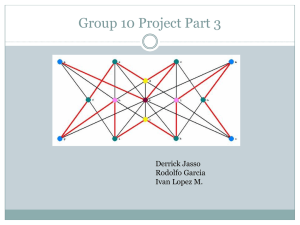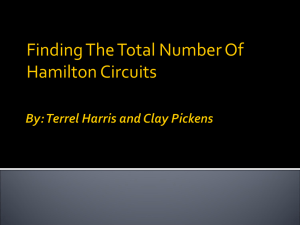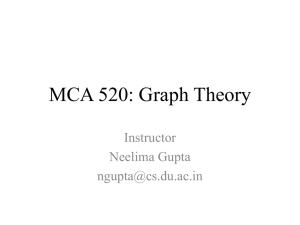pptx
advertisement
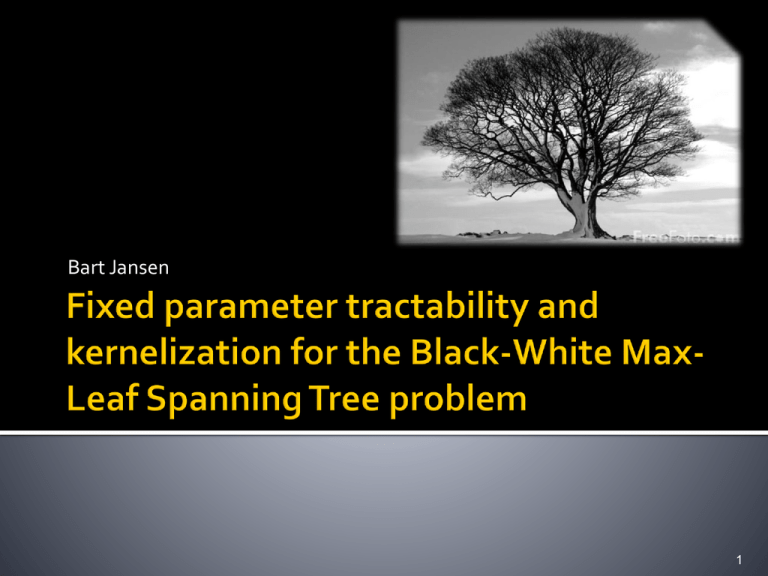
Bart Jansen
1
Problem definition
Instance: Connected graph G, positive integer k
Question: Is there a spanning tree for G with at least k
leaves?
This problem is NP-complete for:
3-regular graphs
• By P. Lemke, 1988
Planar graphs of maximum degree 4
• By Garey and Johnson, 1979
2
3
Problem definition
Instance: Connected bipartite graph G with vertex sets
X and Y, positive integer k
Question: Is there a spanning tree for G with at least k
leaves in the set X?
This problem is NP-complete for:
Planar graphs of maximum degree 4
• Li and Toulouse, 2006
4
Problem definition
Instance: Connected graph G, with an integer
weight for each vertex, positive integer k
Question: Is there a spanning tree for G such that
the leaves have combined weight at least k?
Generalization of bipartite and regular max
leaf
So NP-complete by restriction
We consider fixed parameter tractability
5
Technique to deal with problems (presumably) not in P
Asks if the exponential explosion of the running time can be
restricted to a “parameter” that measures some
characteristic of the instance
An instance of a parameterized problem is:
<I,k> where k is the parameter of the problem (often integer)
Class of Fixed Parameter Tractable (FPT) problems:
Decision problems that can be solved in f(k) * poly(|I| + k) time
Function f can be arbitrary, so dependency on k may be exponential
For example, the k-Vertex Cover problem is fixed parameter
tractable.
“Is there a vertex cover of size k?”
k-Vertex Cover can be solved in O(n + 2k k2) (and even faster).
6
A kernelization algorithm:
Reduces parameterized instance <I,k> to equivalent <I’,k’>
Size of I’ does not depend on I but only on k
Time is poly (|I| + k)
If |I’| is O(g(k)), then g is the size of the kernel
Kernelization algorithm implies fixed parameter
tractability
Compute a kernel, analyze it by brute force
7
Existing problems, parameterized by nr. of leaves
Regular max-leaf has a 3.5k kernel
No FPT results for bipartite max-leaf
Our general-weight problem
We take the target weight k as the parameter of the
problem
Complexity depends on the range of possible weights
Complexity of
weighted max-leaf
General graphs
Planar graphs
Weights {0,1}
W[1] hard
FPT: Kernel of 540k
Weights {0,1,.. }
W[1] hard
FPT: Reduction to bounded treewidth
Weights {1,2,.. }
FPT: Kernel of 9.5k
FPT: Kernel of 9.5k
8
Proving W[1] hardness
9
We refer to the problem with weights in {0,1}
as the Black-White Max-Leaf Spanning tree
problem
Vertices with weight 1 are marked black
Vertices with weight 0 are marked white
We will prove that Black-White Max Leaf is
hard for W[1]
10
Unless the Exponential Time
Hypothesis is false, being W[1]
hard implies:
No f(k)*p(n) algorithm
No polynomial-size kernel
Problems complete for W[2] are
harder than those complete for
W[1]
For weighted max leaf:
No proof of membership in W[1]
It might be harder than any problem
in W[1]
No hardness proof for W[2] either
Fixed parameter tractable
•
•
•
•
Vertex cover
Feedback vertex set
Max-leaf spanning tree
..
W[1] complete
• Independent set
• Set packing
• ..
W[2] complete
• Dominating set
• ..
11
W[i] hardness is proven by parameterized
reduction <I,k> <I’,k’> from some W[i]hard problem
Like (Karp) reductions for NP-completeness
Extra condition: new parameter k’ ≤ f(k) for some f
We reduce k-Independent Set (W[1]complete) to Black-White Max-Leaf
12
k-Independent Set
Instance: Graph G, positive integer k
Question: Does G have an independent set of size
at least k?
▪ (i.e. is there a vertex set S of size at least k, such that no
vertices in S are connected by an edge in G?)
Parameter: the value k.
Assume |V| ≥ 3, |E| ≥ 1
If not, we can brute force and reduce to a trivial
YES or NO instance
13
Given an instance of
k-Independent Set, we
reduce as follows:
Color all vertices black
Split all edges by a white
vertex
Add direct edges
between all black
vertices
Set k’ = k
Polynomial time
k’ ≤ f(k) = k
14
At least 1 edge, so at least 1 vertex outside independent set S
Complement of S is a vertex cover
Build spanning tree:
Take one vertex outside S as root, connect to all blacks
We reach the white vertices from V – S
▪ Since every white used to be an edge, and V – S is a vertex cover
Edges between black
vertices are not drawn
15
Take the black leaves as the independent set
If G has an edge between black x,y then they are not both leaves
One of {x,y} must connect to the white and to the outside
There are at least 3 black vertices, so there is an outside
By contraposition, black leaves form an independent set
Edges between black
vertices are not drawn
16
A linear kernel for Black-White Max-Leaf Spanning Tree
17
Kernel of size 540k
540k
Yields trivial FPT algorithm of
+ poly (|V|, |E|)
k
Strategy:
Give reduction rules
▪ that can be applied in polynomial time
▪ that reduce the instance to an equivalent instance
Prove that after exhaustive application of the rules, either:
▪ the size of the graph is bounded by O(k)
▪ or we are sure that the answer is yes
▪ then we output a trivial, constant-sized YES-instance
18
A cut vertex is a vertex
whose removal splits the
graph into multiple
connected components
A bridge is an edge
whose removal
disconnects the graph
A c-path of length k is a
path
<x,v1,v2, .. , vk,y>, s.t.
x, y have degree ≥ 3
all vi have degree 2
19
Structure:
black cut vertex x
Operation:
color x white
Justification:
In a tree, vertex x must have degree ≥ 2 to be spanning
Vertex x will never count as a black leaf, so we can make it
white
20
Structure:
Operation:
two adjacent white vertices x, y
contract the edge xy, let w be the merged vertex
Justification:
Tree T Tree T’:
▪
▪
There always is an optimal tree that uses xy
Add xy to tree, remove an edge from resulting cycle
▪ Since endpoints of added edge are white, no loss of black leaves
▪
Contract the edge xy to obtain T’
Tree T’ Tree T:
▪
Split w into two vertices x, y and connect to neighbors
21
Structure:
vertex x of degree 1 adjacent to y of degree > 1
Operation:
delete x, decrease k by one
Justification:
Vertex y is a cut vertex, by Rule 1 it is white
Edge xy still exists, by Rule 2 vertex x is black
Since x has degree 1, it will always be a black leaf
So delete it and decrease k by one
k’ = k - 1
22
Structure:
two adjacent degree-2 black vertices x and y
Operation:
remove edge xy
Justification:
Endpoints of a bridge are cut vertices
▪ Would be colored white by Rule 1
▪ So edge xy is not a bridge
There is always an optimal tree without xy
▪
▪
▪
▪
Suppose an optimal tree T uses xy
Remove xy from T
Since xy is no bridge, there is another edge uv we can add to make T spanning again
We can’t lose more black leaves by adding uv than we gain by removing xy
23
Structure:
consecutive vertices x, y, z of degree 2 on a path, with x black
Operation:
contract x, y and z into a single black vertex w
Justification:
By rule 4, vertex y is white.
By rule 2, vertex z is black.
The two spanning trees are equivalent:
▪ We can connect the yellow vertices without getting any leaves
▪ If we don’t connect the yellows, we can get one black leaf and one yellow must
be internal
24
Structure:
two c-paths of length 1 between x and y
the remainder of the graph R is not empty
Operation:
remove v and its incident edges
Justification:
Tree T Tree T’:
▪ One of {u,v} has degree 1 to avoid a cycle
▪ Delete it, and call the remaining white vertex u
Tree T’ Tree T:
▪ One of {x,y} is internal in T’ to connect u to R
▪ Add vertex v, and connect to it from the internal
25
Structure:
c-path of a single white vertex z between vertices x and y of degree ≥ 3
a direct edge xy
Operation:
remove the edge xy
Justification:
There is always an optimal tree that avoids xy
▪
▪
▪
▪
▪
Consider a tree T that uses xy
To avoid a cycle, it avoids one of {a,b}
It must use the other of {a,b} to be spanning
Delete xy from T, and add the other edge of {a,b}
Number of black leaves does not decrease, tree is still optimal
26
We apply the reduction rules in the given order, until no rule is applicable
Can easily be done in polynomial time
Reduced graph is still planar, since all we do is:
Contract an edge, remove an edge, remove a vertex, re-color a vertex.
Reduced instance is highly structured:
White vertices form an independent set
All vertices have degree ≥ 2
All cut vertices are white
Colors alternate black/white on c-paths
No c-paths of size > 3
…
27
Rule 1: re-color cut vertices
Makes good sense, brings structure in the
problem
Rule 3: remove degree-1 black vertices
Decreases the size of the graph
For the remaining rules
If you remove a single reduction rule
▪ there are irreducible graphs of arbitrary size with only a
constant number of black leaves
So no kernel!
28
Claim: If a reduced instance <G,k> has more
than 540k vertices,
then it must contain a spanning tree with ≥ k black
leaves
So in our kernelization algorithm:
If |G| > 540k, we create a trivial YES-instance and
output it
Otherwise, we output <G,k>
29
For regular Max-Leaf, there is the following lemma:
Any graph of minimum degree ≥ 3 has a spanning tree
with |G|/4 leaves
Others used this for kernelization, by reducing to a graph
of min. degree ≥ 3
For this kernel, we need:
Any reduced instance has a spanning tree with at least c|G|
black leaves, for some c > 0
No structural result available in literature, so I proved
one myself
Currently: c = 1/540
There are reduced graphs with only |G|/18 black leaves in
an optimal spanning tree, so we can’t prove c<1/18
30
If S is a connected dominating set, then we can always find a
spanning tree in which V – S are leaves
Build a spanning tree on S
▪ Possible because S is connected
Add an edge from S to every vertex in V – S
▪ Possible because S is dominating
Small connected dominating setspanning tree with many leaves
31
The leaf-to-blacks ratio in a reduced instance, is no worse than the leafto-blacks ratio in a bipartite reduced instance
A leafy spanning tree corresponds to a small connected dominating set
Shown on previous slide
In a bipartite reduced instance, the white vertices form a dominating
set
Reduced instance has no white-white edges, but might have black-black
edges
In any bipartite graph, any of the two vertex sets dominates the other half
So if we take all white vertices, we have a dominating set
We need to make it connected by adding black vertices
32
We give a greedy strategy that connects the dominating set:
Find a black vertex adjacent to maximum number of different connected
components of S
Add that vertex to S
We evaluate the performance of this strategy, and show it always adds at
most a 89/90 fraction of all black vertices to S.
So at least 1/90 of all the black vertices can become a leaf in the equivalent
spanning tree
Evaluation uses original techniques:
We derive inequalities that hold for the intermediate stages of the dominating
set
These express the number of blacks not taken in the set, in the degrees of the
blacks that were added to the set
We relax these inequalities into a linear program, and minimize the variable
that represents the fraction of black vertices outside S
The outcome of the LP shows the minimum fraction of black vertices that can
become a leaf in a good spanning tree for a bipartite reduced instance
33
So we proved that:
a constant fraction of the black vertices in a reduced
instance can become leaves
We need:
a constant fraction of the total number of vertices (blacks
and whites) can become black leaves
This is achieved by proving:
W ≤ 5B for all reduced instances
Combining with earlier results, we find that for a
reduced instance:
there is always a spanning tree in which at least (1/90)/6 =
1/540 of all vertices are black leaves.
Which proves the kernelization lemma.
34
Generalizing the kernel for black/white on planar
graphs
To graphs of bounded genus
To a kernel for arbitrary weights on planar graphs
Determining complexity for arbitrary, real-valued
weights
Determining the quality of the approximation
algorithm for bipartite max-leaf
Only known approximation algorithm for bipartite max-
leaf is for regular graphs
Our strategy is a constant-factor approximation, for some
factor ≤ 540
35



